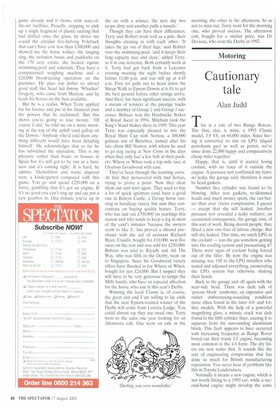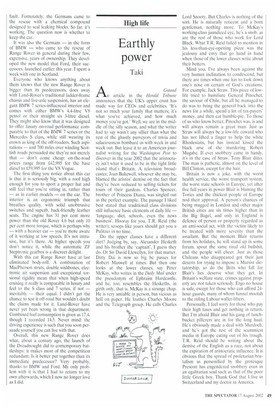Motoring
Cautionary tale
Alan Judd
This is a tale of two Range Rovers. The first, alas, is mine, a 1993 Classic model, 3.9 V8, on 64.000 miles. Since having it converted to run on LPG (liquid petroleum gas) as well as petrol, we've since done 22,000 happy and comparatively cheap miles together.
Happy, that is, until it started losing coolant, with no trace of it outside the engine. A pressure test confirmed my fears: no leaks, the garage said, therefore it must be head gaskets.
Number five cylinder was found to be blowing. After new gaskets, re-skimmed heads and much money spent, she ran better than ever (more compression, I guess) — except that she still leaked. Another pressure test revealed a leaky radiator, an occasional consequence, the garage said, of this sort of work. Being decent people, they fitted a new one free of labour charge. But still she leaked. This time, we smelt LPG in the coolant — was the gas somehow getting into the cooling system and pressurising it? There were signs of coolant being forced out of the filler. By now the engine was missing, too. Off to the LPG installers who tested and adjusted everything, exonerating the LPG system but otherwise shaking their heads.
Back to the garage and off again with the near-side head. There was dark talk of 'porous block' syndrome, an expensive and rather embarrassing-sounding condition more often found in the later 4.0and 4.6litre models. With the help of a powerful magnifying glass, a minute crack was duly found in the fifth cylinder liner, causing it to separate from the surrounding aluminium block. This fault appears to have occurred with increasing frequency as Range Rover bored out their trusty 3.5 engine, becoming most common in the 4.6 form. The dry liners are now wafer thin. It sounds like the sort of engineering compromise that has done so much for British manufacturing reputation. You never hear of problems like this in Toyota Landcruisers.
Normally it means a new engine, which is not worth fitting to a 1993 car, while a second-hand engine might develop the same fault. Fortunately, the Germans came to the rescue with a chemical compound designed to seal leaking blocks. So far. it's working. The question now is whether to keep the car.
It was also the Germans — in the form of BMW — who came to the rescue of Range Rover in general during their few, expensive, years of ownership. They developed the new model that Ford, their successors, launched earlier this year. I spent a week with one in Scotland.
Everyone who knows anything about them knows that the new Range Rover is bigger than its predecessors, does away with Land-Rover's traditional ladder-frame chassis and live-axle suspension, has an elegant BMW 7 series-influenced interior and comes with either BMW's 4.4-litre VS petrol or their straight six 3-litre diesel. They might also know that it was designed to offer luxury on-road performance comparable to that of the BMW 7 series or the Mercedes S class, while still wearing its crown as king of the off-roaders. Such aspirations — and 700 miles over winding Scottish roads persuaded me they're not merely that — don't come cheap: on-the-road prices range from £42,995 for the base diesel to £59,995 for the VS Vogue.
The first thing you notice about this car is that it is seriously big, with a roof high enough for you to sport a proper hat and still feel that you're sitting in, rather than — as in earlier models — on the car. The interior is an ergonomic triumph that breathes quality, with solid unobtrusive switches and superb, back-friendly leather seats. The engine has 31 per cent more power than the old Rover 4.6 but only 10 per cent more torque, which is perhaps why — with a heavier car — you're more aware of it working at low speeds. It's not intrusive, but it's there. At higher speeds you don't notice it, while the automatic 7.F Steptronic gearbox is a discreet delight.
With this car Range Rover have at last eliminated body-roll. A combination of MacPherson struts, double wishbones, electronic air suspension and exceptional torsional rigidity mean that when high-speed cruising it really is comparable in luxury and feel to the S class and 7 series, if not — inevitably — their equal. I didn't get the chance to test it off-road but wouldn't doubt the claims made for it. Land-Rover have never yet been wrong in that department. Combined fuel consumption is given as 17.4, though 1 recorded 14.5. Never mind: the driving experience is such that you soon persuade yourself you can live with that.
Overall, this new Range Rover does what, about a century ago, the launch of the Dreadnought did to contemporary battleships: it makes most of the competition redundant. Is it better put together than its immediate predecessor? Very probably, thanks to BMW and Ford. My only problem with it is that I had to return to my own afterwards, which I now no longer love as I did.































































 Previous page
Previous page